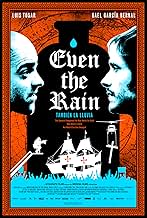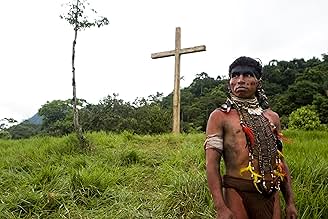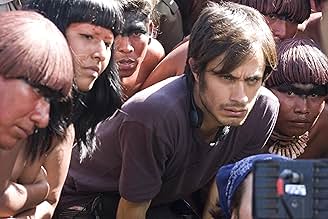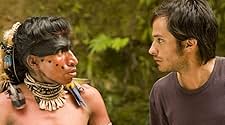IMDb-BEWERTUNG
7,4/10
14.451
IHRE BEWERTUNG
Während ein Regisseur und sein Filmteam einen umstrittenen Film über Christoph Kolumbus in Cochabamba in Bolivien drehen, protestieren die Einheimischen gegen Pläne zur Privatisierung der Wa... Alles lesenWährend ein Regisseur und sein Filmteam einen umstrittenen Film über Christoph Kolumbus in Cochabamba in Bolivien drehen, protestieren die Einheimischen gegen Pläne zur Privatisierung der Wasserversorgung.Während ein Regisseur und sein Filmteam einen umstrittenen Film über Christoph Kolumbus in Cochabamba in Bolivien drehen, protestieren die Einheimischen gegen Pläne zur Privatisierung der Wasserversorgung.
- Auszeichnungen
- 22 Gewinne & 17 Nominierungen insgesamt
Handlung
WUSSTEST DU SCHON:
- WissenswertesThe scene where the little girl sees herself on screen was kind of a self homage by director/actress Icíar Bollaín. She wanted to transmit her first impression when she saw herself on screen being a teenager.
- VerbindungenFeatured in Ebert Presents: At the Movies: Folge #1.6 (2011)
Ausgewählte Rezension
As a director named Sebastian (Gael Garcia Bernal)and his crew formed by his executive producer named Costa (Luis Tosar) and actors realize a controversial film about Christopher Columbus (Karra Elejalde) Bartolome De Las Casas (Raul Arevalo) , Montesinos (Carlos Santos) in Cochabamba , Bolivia, local people rise up against schemes to privatize the water supply . Spain Conquered the New World for Gold 500 Years Later, Water is Gold Not Much Else has Changed. Costa has chosen this place because the budget of the film is tight and extras are cheap , as he hires a rebel native (Iduviri) . The only thing that matters to him is his professional pride as a producer that the film is made on time and within budget.
This is an interesting and thought-provoking film dealing with actual and past deeds as the first explorations and the way the Spaniards treated the Indians at the time, the Cochabamba revolts , being well interwoven by screenwriter Paul Laverty and director . Top-notch main cast such as Gael Garcia Bernal as a good , idealist filmmaker and Luis Tosar as a selfish producer who wishes hire supernumeraries, local actors and extras on the cheap . Very good cinematography by Alex Catalan . Emotive and sensitive musical score by Alberto Iglesias .
The real events in which this brooding movie are based result to be the following : The Cochabamba protests of 2000, also known as the "Cochabamba Water Wars", were a series of protests that took place in Cochabamba, Bolivia's third largest city, between January 1999 and April 2000 in response to multinational participation in the infrastructure and management of the city's municipal water supply. Demonstrations erupted when Aguas del Tunari imposed a large rate increase, reportedly to finance a Dam project, a week after taking control of the Cochabamba water supply system. In a country where the minimum wage was less than US$70 per month, many dwellers were hit with monthly water bills of $20 or more. Starting in early January 2000 massive protests in Cochabamba began with Oscar Olivera among the most outspoken leaders against the rate hikes and subsequent water cut-offs. The demonstrators consisted of peasant Irrigators who entered the city either under village banners, or carrying the Wiphala; they were joined by retired . Young men began to try to take over the plaza and a barricade across incoming roadways was set up. Soon they were joined by pieceworkers, sweatshop employees, and street vendors . Anarchists from the middle-classes came from the University of Cochabamba to denounce the World Bank and International Monetary Fund and neoliberalism. The strongest supporters of the demonstration were drawn from the city's growing population of homeless street children .Protesters were able to halt Cochabamba's economy by holding a general strike that shut down the city for four straight days. A ministerial delegation went to Cochabamba and agreed to roll back the water rates; still the demonstration continued.On February 4, 2000, thousands marching in protest were met by troops and law enforcement . Almost 200 demonstrators were arrested; 70 protesters and 51 policemen were injured.Throughout March 2000 the Bolivian hierarchy of the Roman Catholic Church tried to mediate between the government and the demonstrators. In the meantime, the Coordinadora made their own referendum and declared that out of fifty thousand votes, 96% demanded the contract with Aguas del Tunari be cancelled. The government's reply under Hugo Banzer was that "There is nothing to negotiate.In April 2000, demonstrators again took over Cochabamba's central plaza. When the leaders of the Coordinadora went to a meeting with the governor at his office they were arrested. Though they were released the following day, some, fearing further government action, fled into hiding. More demonstration leaders were arrested, with some being transferred to a jungle prison in San Joaquin, a remote town in the Amazon rain forest on the border with Brazil. The demonstrations spread quickly to other areas including La Paz, Oruro, and Potosí as well as rural areas. The protesters also expanded their demands calling on the government to resolve unemployment and other economic problems.Soon demonstrators had most of the major highways in Bolivia barricaded. The protest even inspired officers in four La Paz police units to refuse to leave their barracks or obey superiors until a wage dispute was settled.
The motion picture is originally directed by Iciar Bollain . She has worked as a leading actress in selected films like The South (1983) by 'Victor Erice', Malaventura (1988) by 'Manuel Gutiérrez Aragon , Land and Freedom (1995) by Ken Loach, it became an acclaimed audience's and critics' choice ; Leo (2000) by 'Jose Luis Borau' that won the Best Actress nomination Goya Spanish Academy Awards and Nos Miran (2002) . She is a prestigious producer , writing and directing since then both documentaries and fiction films. In 1995, she wrote and directed her feature film debut, ¨Hola, ¿estás Sola?¨ (1995), awarded with Best New Director in Valladolid Festival and was nominated for Best Directorial Debut by the Spanish Film Academy. The film became one of Spain's 1996 box office hits. Flowers from another world(1999), was her second feature film and was awarded at Cannes Film Festival 1999, Best Film in the International Critics' Week ; ¨Take my eyes, 2003¨, was her following film as writer and director, winner of 7 Goyas Spanish Academy Awards, including Best Film, among many other international awards. Her next feature film is ¨Mataharis (2007)¨ and is filming ¨Katmandu¨.
This is an interesting and thought-provoking film dealing with actual and past deeds as the first explorations and the way the Spaniards treated the Indians at the time, the Cochabamba revolts , being well interwoven by screenwriter Paul Laverty and director . Top-notch main cast such as Gael Garcia Bernal as a good , idealist filmmaker and Luis Tosar as a selfish producer who wishes hire supernumeraries, local actors and extras on the cheap . Very good cinematography by Alex Catalan . Emotive and sensitive musical score by Alberto Iglesias .
The real events in which this brooding movie are based result to be the following : The Cochabamba protests of 2000, also known as the "Cochabamba Water Wars", were a series of protests that took place in Cochabamba, Bolivia's third largest city, between January 1999 and April 2000 in response to multinational participation in the infrastructure and management of the city's municipal water supply. Demonstrations erupted when Aguas del Tunari imposed a large rate increase, reportedly to finance a Dam project, a week after taking control of the Cochabamba water supply system. In a country where the minimum wage was less than US$70 per month, many dwellers were hit with monthly water bills of $20 or more. Starting in early January 2000 massive protests in Cochabamba began with Oscar Olivera among the most outspoken leaders against the rate hikes and subsequent water cut-offs. The demonstrators consisted of peasant Irrigators who entered the city either under village banners, or carrying the Wiphala; they were joined by retired . Young men began to try to take over the plaza and a barricade across incoming roadways was set up. Soon they were joined by pieceworkers, sweatshop employees, and street vendors . Anarchists from the middle-classes came from the University of Cochabamba to denounce the World Bank and International Monetary Fund and neoliberalism. The strongest supporters of the demonstration were drawn from the city's growing population of homeless street children .Protesters were able to halt Cochabamba's economy by holding a general strike that shut down the city for four straight days. A ministerial delegation went to Cochabamba and agreed to roll back the water rates; still the demonstration continued.On February 4, 2000, thousands marching in protest were met by troops and law enforcement . Almost 200 demonstrators were arrested; 70 protesters and 51 policemen were injured.Throughout March 2000 the Bolivian hierarchy of the Roman Catholic Church tried to mediate between the government and the demonstrators. In the meantime, the Coordinadora made their own referendum and declared that out of fifty thousand votes, 96% demanded the contract with Aguas del Tunari be cancelled. The government's reply under Hugo Banzer was that "There is nothing to negotiate.In April 2000, demonstrators again took over Cochabamba's central plaza. When the leaders of the Coordinadora went to a meeting with the governor at his office they were arrested. Though they were released the following day, some, fearing further government action, fled into hiding. More demonstration leaders were arrested, with some being transferred to a jungle prison in San Joaquin, a remote town in the Amazon rain forest on the border with Brazil. The demonstrations spread quickly to other areas including La Paz, Oruro, and Potosí as well as rural areas. The protesters also expanded their demands calling on the government to resolve unemployment and other economic problems.Soon demonstrators had most of the major highways in Bolivia barricaded. The protest even inspired officers in four La Paz police units to refuse to leave their barracks or obey superiors until a wage dispute was settled.
The motion picture is originally directed by Iciar Bollain . She has worked as a leading actress in selected films like The South (1983) by 'Victor Erice', Malaventura (1988) by 'Manuel Gutiérrez Aragon , Land and Freedom (1995) by Ken Loach, it became an acclaimed audience's and critics' choice ; Leo (2000) by 'Jose Luis Borau' that won the Best Actress nomination Goya Spanish Academy Awards and Nos Miran (2002) . She is a prestigious producer , writing and directing since then both documentaries and fiction films. In 1995, she wrote and directed her feature film debut, ¨Hola, ¿estás Sola?¨ (1995), awarded with Best New Director in Valladolid Festival and was nominated for Best Directorial Debut by the Spanish Film Academy. The film became one of Spain's 1996 box office hits. Flowers from another world(1999), was her second feature film and was awarded at Cannes Film Festival 1999, Best Film in the International Critics' Week ; ¨Take my eyes, 2003¨, was her following film as writer and director, winner of 7 Goyas Spanish Academy Awards, including Best Film, among many other international awards. Her next feature film is ¨Mataharis (2007)¨ and is filming ¨Katmandu¨.
Top-Auswahl
Melde dich zum Bewerten an und greife auf die Watchlist für personalisierte Empfehlungen zu.
- How long is Even the Rain?Powered by Alexa
Details
- Erscheinungsdatum
- Herkunftsländer
- Offizielle Standorte
- Sprachen
- Auch bekannt als
- Even the Rain
- Drehorte
- Produktionsfirmen
- Weitere beteiligte Unternehmen bei IMDbPro anzeigen
Box Office
- Bruttoertrag in den USA und Kanada
- 518.017 $
- Eröffnungswochenende in den USA und in Kanada
- 53.730 $
- 20. Feb. 2011
- Weltweiter Bruttoertrag
- 7.313.485 $
- Laufzeit1 Stunde 43 Minuten
- Farbe
- Sound-Mix
- Seitenverhältnis
- 2.35 : 1
Zu dieser Seite beitragen
Bearbeitung vorschlagen oder fehlenden Inhalt hinzufügen

Oberste Lücke
By what name was Und dann der Regen - También la lluvia (2010) officially released in India in English?
Antwort
















